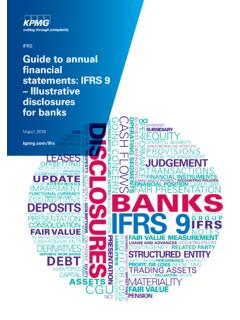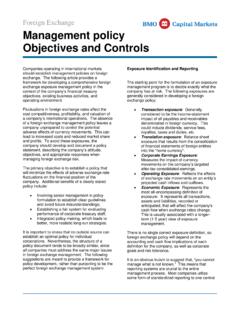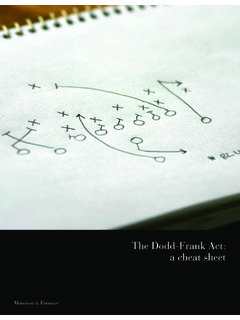Transcription of Causes of the Financial Crisis - Federation of American ...
1 Causes of the Financial Crisis Mark Jickling Specialist in Financial Economics April 9, 2010. Congressional Research Service 7-5700. R40173. CRS Report for Congress Prepared for Members and Committees of Congress Causes of the Financial Crisis Summary The current Financial Crisis began in August 2007, when Financial stability replaced inflation as the Federal Reserve's chief concern. The roots of the Crisis go back much further, and there are various views on the fundamental Causes . It is generally accepted that credit standards in mortgage lending were relaxed in the early 2000s, and that rising rates of delinquency and foreclosures delivered a sharp shock to a range of Financial institutions. Beyond that point of agreement, however, there are many questions that will be debated by policymakers and academics for decades. Why did the Financial shock from the housing market downturn prove so difficult to contain?
2 Why did the tools the Fed used successfully to limit damage to the Financial system from previous shocks (the Asian crises of 1997-1998, the stock market crashes of 1987 and 2000-2001, the junk bond debacle in 1989, the savings and loan Crisis , 9/11, and so on) fail to work this time? If we accept that the origins are in the United States, why were so many Financial systems around the world swept up in the panic? To what extent were long-term developments in Financial markets to blame for the instability? Derivatives markets, for example, were long described as a way to spread Financial risk more efficiently, so that market participants could bear only those risks they understood. Did derivatives, and other risk management techniques, actually increase risk and instability under Crisis conditions? Was there too much reliance on computer models of market performance? Did those models reflect only the post-WWII period, which may now come to be viewed not as a typical 60-year period, suitable for use as a baseline for Financial forecasts, but rather as an unusually favorable period that may not recur?
3 Did government actions inadvertently create the conditions for Crisis ? Did regulators fail to use their authority to prevent excessive risk-taking, or was their jurisdiction too limited and/or compartmentalized? The multiple roots of the Crisis are mirrored in the policy response. Two bills in the 111th Congress 4173, passed by the House on December 11, 2009, and Senator Dodd's Restoring American Financial Stability Act, as ordered reported by the Senate Banking Committee on March 22, 2010 address many of the purported causal factors across the entire Financial system. The bills address systemic risk, too-big-to-fail, prudential supervision, hedge funds, derivatives, payments systems, credit rating agencies, securitization, and consumer Financial protection. (For a summary of major provisions, see CRS Report R40975, Financial Regulatory Reform and the 111th Congress, coordinated by Baird Webel.).
4 This report consists of a table that presents very briefly some of the arguments for particular Causes , presents equally brief rejoinders, and includes a reference or two for further reading. It will be updated as required by market developments. Introduction The Financial Crisis that began in 2007 spread and gathered intensity in 2008, despite the efforts of central banks and regulators to restore calm. By early 2009, the Financial system and the global Congressional Research Service Causes of the Financial Crisis economy appeared to be locked in a descending spiral, and the primary focus of policy became the prevention of a prolonged downturn on the order of the Great Depression. The volume and variety of negative Financial news, and the seeming impotence of policy responses, has raised new questions about the origins of Financial crises and the market mechanisms by which they are contained or propagated.
5 Just as the economic impact of Financial market failures in the 1930s remains an active academic subject, it is likely that the Causes of the current Crisis will be debated for decades to come. This report sets out in tabular form a number of the factors that have been identified as Causes of the Crisis . The left column of Table 1 below summarizes the causal role of each such factor. The next column presents a brief rejoinder to that argument. The right-hand column contains a reference for further reading. Where text is given in quotation marks, the reference in the right column is the source, unless otherwise specified. Congressional Research Service 4. Table 1. Causes of the Financial Crisis Cause Argument Rejoinder Additional Reading Imprudent Mortgage Against a backdrop of abundant credit, low interest rates, and Imprudent lending certainly played a role, CRS Report RL33775, Alternative Lending rising house prices, lending standards were relaxed to the point but subprime loans (about $ trillion at Mortgages: Causes and Policy that many people were able to buy houses they couldn't afford.)
6 The peak) were a relatively small part of Implications of Troubled Mortgage When prices began to fall and loans started going bad, there was a the overall mortgage market (about Resets in the Subprime and Alt-A. severe shock to the Financial system. $11 trillion) and of total credit market Markets, by Edward V. Murphy. debt outstanding (about $50 trillion). Housing Bubble With its easy money policies, the Federal Reserve allowed housing It is difficult to identify a bubble until it CRS Report RL33666, Asset prices to rise to unsustainable levels. The Crisis was triggered by bursts, and Fed actions to suppress the Bubbles: Economic Effects and Policy the bubble bursting, as it was bound to do. bubble may do more damage to the Options for the Federal Reserve, by economy than waiting and responding to Marc Labonte. the effects of the bubble bursting. Global Imbalances Global Financial flows have been characterized in recent years by None of the adjustments that would Lorenzo Bini Smaghi, The Financial an unsustainable pattern: some countries (China, Japan, and reverse the fundamental imbalances has yet Crisis and global imbalances two Germany) run large surpluses every year, while others (like the occurred.
7 That is, there has not been a sides of the same coin, Speech at and UK) run deficits. The external deficits have been sharp fall in the dollar's exchange value, the Asia Europe Economic Forum, mirrored by internal deficits in the household and government and deficits persist. Beijing, Dec. 9, 2008. sectors. borrowing cannot continue indefinitely; the resulting stress underlies current Financial disruptions. Securitization Securitization fostered the originate-to-distribute model, which Mortgage loans that were not securitized, Statement of Alan Greenspan reduced lenders' incentives to be prudent, especially in the face of but kept on the originating lender's books, before the House Committee on vast investor demand for subprime loans packaged as AAA bonds. have also done poorly. Oversight and Government Ownership of mortgage-backed securities was widely dispersed, Reform, October 23, 2008. ( The causing repercussions throughout the global system when breakdown has been most subprime loans went bad in 2007.
8 Apparent in the securitization of home mortgages. ). CRS-5. Cause Argument Rejoinder Additional Reading Lack of Transparency Throughout the housing finance value chain, many participants Many contractual arrangements did Statement of the Honorable John and Accountability in contributed to the creation of bad mortgages and the selling of provide recourse against sellers or issuers W. Snow before the House Mortgage Finance bad securities, apparently feeling secure that they would not be of bad mortgages or related securities. Committee on Oversight and held accountable for their actions. A lender could sell exotic Many non-bank mortgage lenders failed Government Reform, October 23, mortgages to home-owners, apparently without fear of because they were forced to take back 2008. repercussions if those mortgages failed. Similarly, a trader could loans that defaulted, and many lawsuits sell toxic securities to investors, apparently without fear of have been filed against MBS issuers and personal responsibility if those contracts failed.
9 And so it was for others. brokers, realtors, individuals in rating agencies, and other market participants, each maximizing his or her own gain and passing problems on down the line until the system itself collapsed. Because of the lack of participant accountability, the originate-to- distribute model of mortgage finance, with its once great promise of managing risk, became itself a massive generator of risk.. Rating Agencies The credit rating agencies gave AAA ratings to numerous issues of All market participants underestimated Securities and Exchange subprime mortgage-backed securities, many of which were risk, not just the rating agencies. Commission, SEC Approves subsequently downgraded to junk status. Critics cite poor Purchasers of MBS were mainly Measures to Strengthen Oversight economic models, conflicts of interest, and lack of effective sophisticated institutional investors, who of Credit Rating Agencies, press regulation as reasons for the rating agencies' failure.
10 Another should have done their own due diligence release 2008-284, Dec. 3, 2008. factor is the market's excessive reliance on ratings, which has been investigations into the quality of the reinforced by numerous laws and regulations that use ratings as a instruments. criterion for permissible investments or as a factor in required capital levels. Mark-to-market FASB standards require institutions to report the fair (or current Many view uncertainty regarding Financial Understanding the Mark-to- Accounting market) value of securities they hold. Critics of the rule argue that institutions' true condition as key to the market Meltdown, Euromoney, this forces banks to recognize losses based on fire sale prices Crisis . If accounting standards however Mar. 2008. that prevail in distressed markets, prices believed to be below imperfect are relaxed, fears that long-term fundamental values. Those losses undermine market published balance sheets are unreliable will confidence and exacerbate banking system problems.














